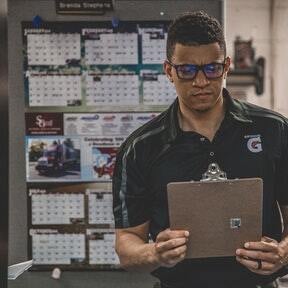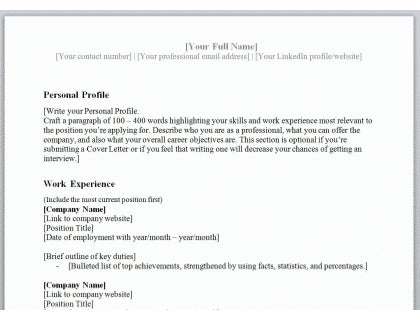Chronological vs. Functional CV:
The main purpose of a chronological CV is to showcase the job seeker's work experience in reverse chronological order. By contrast, a functional CV focuses on a job applicant's skills, providing a detailed list at the top of the CV.
How to Write a Chronological CV:

Regardless of the type of CV you choose, there are basic guidelines you'll need to follow. Check out our article on how to write a CV to find out how to construct each section and impress the hiring manager. Below, we also list our guidelines for creating a chronological CV.
Guidelines for writing a Chronological CV.
Provide your contact details.

Include your name and contact details in the header of your CV. Use a professional email address and a reliable contact number. You may include your LinkedIn profile or your website address if it is relevant to the job you're applying for.
Add a personal profile.

Include a personal profile beneath your contact details if you're not submitting a cover letter with your application, and you feel that it could improve your chances of getting an interview.
Outline your qualifications.

List your academic qualifications, starting with the most recently obtained ones. Mention any degrees, diplomas, or certificates that are relevant for the position.
Include your skills list.

List both hard and soft skills, limiting this section to between five and ten points. If you include additional sections, always list them in a logical order. You may also bold and increase the size of all the headings.
Never include false information or try to hide gaps in your CV.
Use professional fonts. graphics, and layout.

Choose a professional font like Times New Roman, Arial, or Helvetica. Use only black and font size 10–12. In addition, refrain from using color or graphics, and remove them if you are using CV builders.
If your CV spans two pages or more, include your name and the page number in the footer.
Review your CV.

Download Grammarly to pick up mistakes and get a trusted friend or colleague to do a final read-through before you submit the application.
Add references.

Generally, references are no longer included on CVs, but you can prepare a separate list in case the employer requests one. Read our resume guide to find out what should be included in this list.

Chronological CV Template in MS Word Format:
Start applying for jobs today using our chronological CV template.
Download NowChronological CV Template: (Text Version)
(In the header)
[Your Full Name]
[Your contact number] | [Your professional email address] | [Your LinkedIn profile/website]
Personal Profile
[Write your personal profile.
Craft a paragraph of 100–400 words highlighting your skills and work experience most relevant to the position you’re applying for. Describe who you are as a professional, what you can offer the company, and what your overall career objectives are. This section is optional if you’re submitting a cover letter or if you feel that writing one will decrease your chances of getting an interview.]
Work Experience
(Include the most current position first)
[Company Name]
[Link to company website]
[Position Title]
[Date of employment with year/month – year/month]
[Brief outline of key duties]
- [Bulleted list of top achievements, strengthened by using facts, statistics, and percentages.]
[Company Name]
[Link to company website]
[Position Title]
[Date of employment with year/month – year/month]
[Brief outline of key duties]
- [Bulleted list of top achievements, strengthened by using facts, statistics, and percentages.]
[Company Name]
[Link to company website]
[Position Title]
[Date of employment with year/month – year/month]
[Brief outline of key duties]
- [Bulleted list of top achievements, strengthened by using facts, statistics, and percentages.]
Academic Qualifications
(Include the most recent/relevant qualifications first)
(Format for New Graduates)
[Qualification]
[Name of institution]
[Location]
[Year started – year ended]
- [Brief overview of your degree/diploma, mentioning significate courses]
- [List any honors/scholarships/awards achieved]
OR
(Format for Experienced Professionals)
[Qualification], [Name of institution], [Location]*
*graduation date not required for experienced applicants.
Skills
[Bulleted list of all key skills relevant to the position. Limit the list to between 5 and 10 skills. Include both hard skills (skills that can be learned and measured) and soft skills (individual traits that are learned through experience and interaction with others).]
Additional Sections
(All of these sections are optional, but experienced candidates may require them. Select those most relevant to you.)
[Books/Chapters]
(Include the titles of the books you’ve written or contributed to. Include the publication date, imprint, and any other relevant details. Can take the form of a bulleted list with short explanations.)
[Journal Articles]
(Include the titles of the journal articles you’ve written or contributed to. Include the publication date, name of the journal the article was published in, and any other relevant details. Can take the form of a bulleted list, with short explanations.)
[Peer-Reviewed Articles]
(Include the titles of the articles you’ve peer-reviewed and any other relevant details.)
[Other Publications]
(Include any other notable works you’ve completed, with their publication dates, and other relevant details.)
[Awards, Honors, or Achievements]
(List the awards you’ve achieved, with brief explanations of them.)
[Additional Certifications or Licenses]
(List any relevant certificates or licenses you hold.)
[Fellowships, Grants, and Scholarships]
(List any fellowships, grants, or scholarships you’ve received, along with their dates, and any other relevant information.)
[Conferences Attended]
(List the conferences you’ve attended, their dates, and where they were held.)
[Presentations or Lectures Delivered]
(List the presentations, lectures, or seminars you’ve delivered, as well as the details thereof.)
[Teaching Experience]
(Mention any teaching or training experience you’ve had, with dates, locations, and other notable details.)
[Non-Academic Activities/Notable Interests & Hobbies]
(If they’re related to the position you’re applying for, include a list of non-academic activities like interests and hobbies.)
[Graduate Fieldwork]
(Include the details of your fieldwork and research.)
[Research or Lab Experience]
(Include the details of your research and lab experience.)
[Additional Languages]
(Mention any additional languages you have learned. Indicate your proficiency as novice, intermediate, or advanced.)
[Memberships]
(Mention any active memberships relevant to your career/the position you’re applying for.)
[Volunteer Work/Initiatives]
(List your volunteer work or the non-profit initiatives you’ve been involved in, as well as the impact you’ve made there.)
[Projects]
(List any projects you’ve initiated or been involved in, as well the details thereof.)
[References]
(Compile a separate list to go at the back of your CV.)

